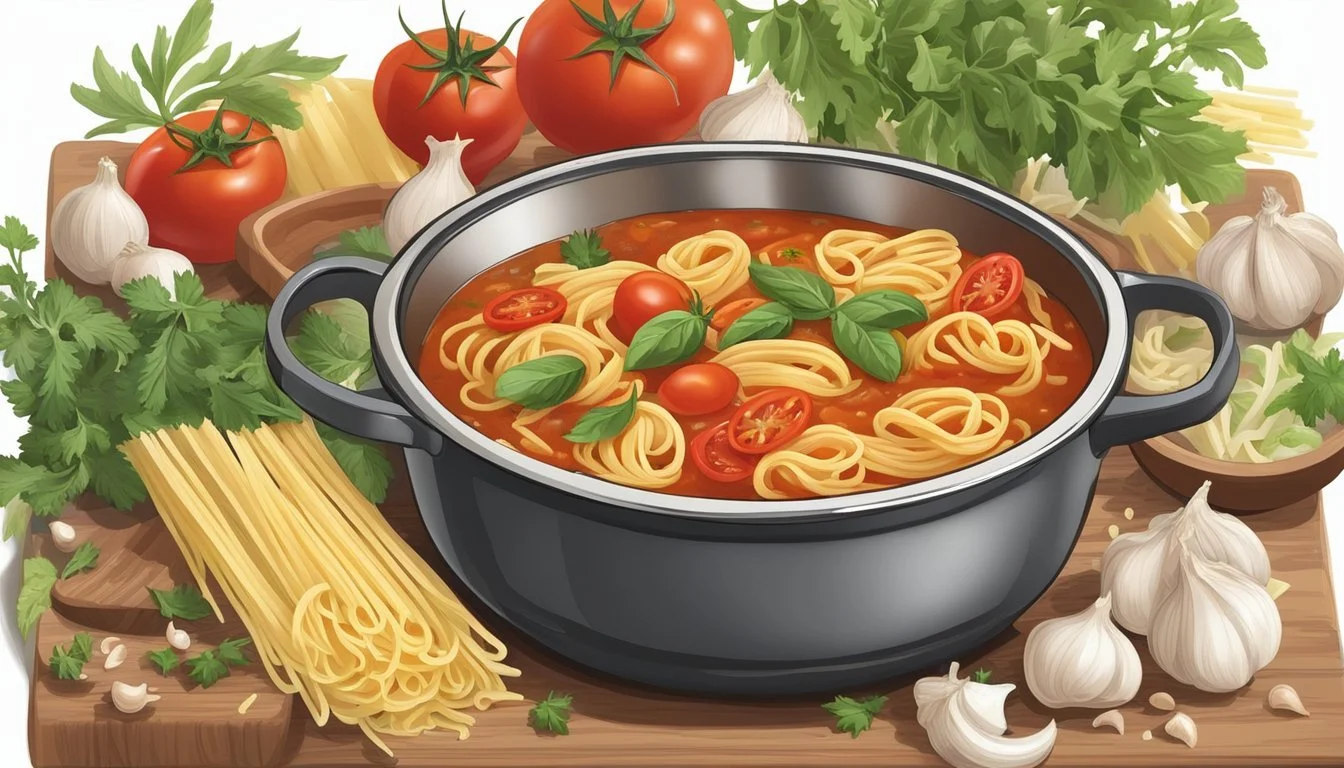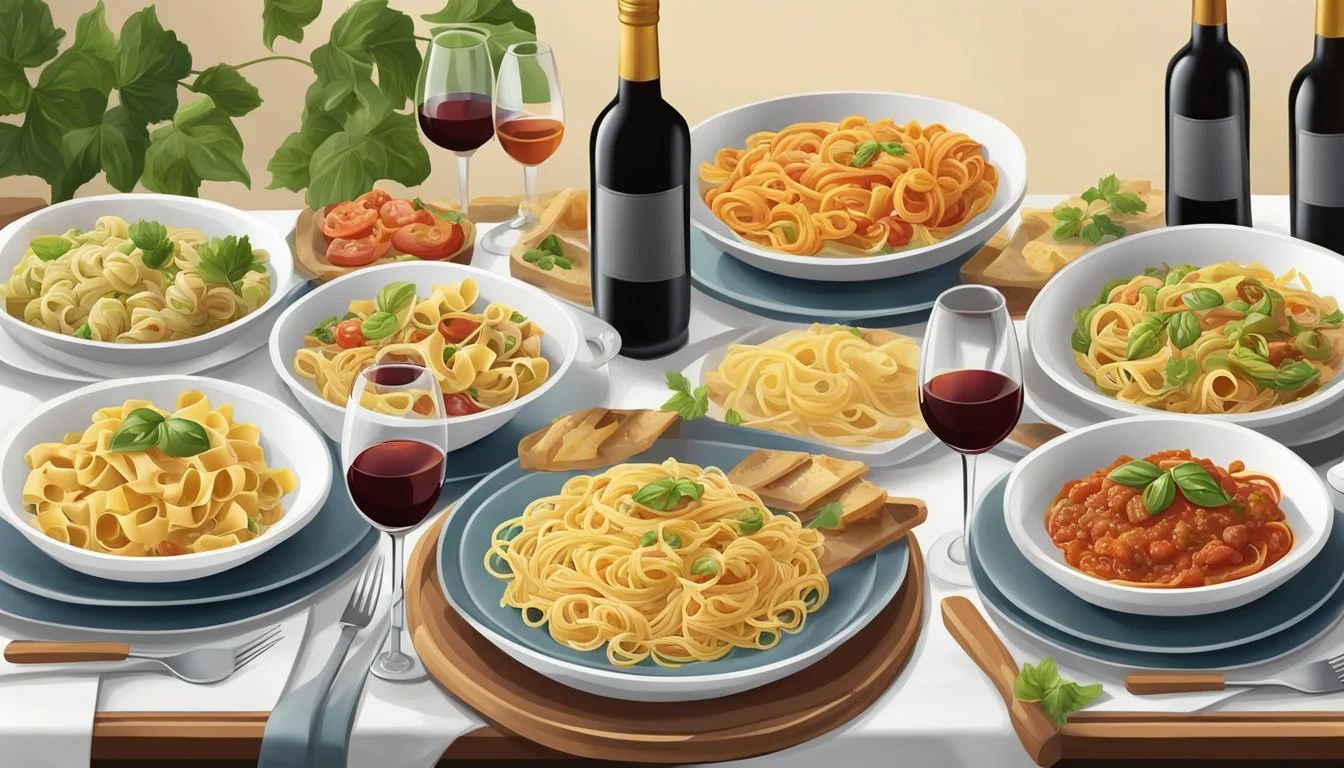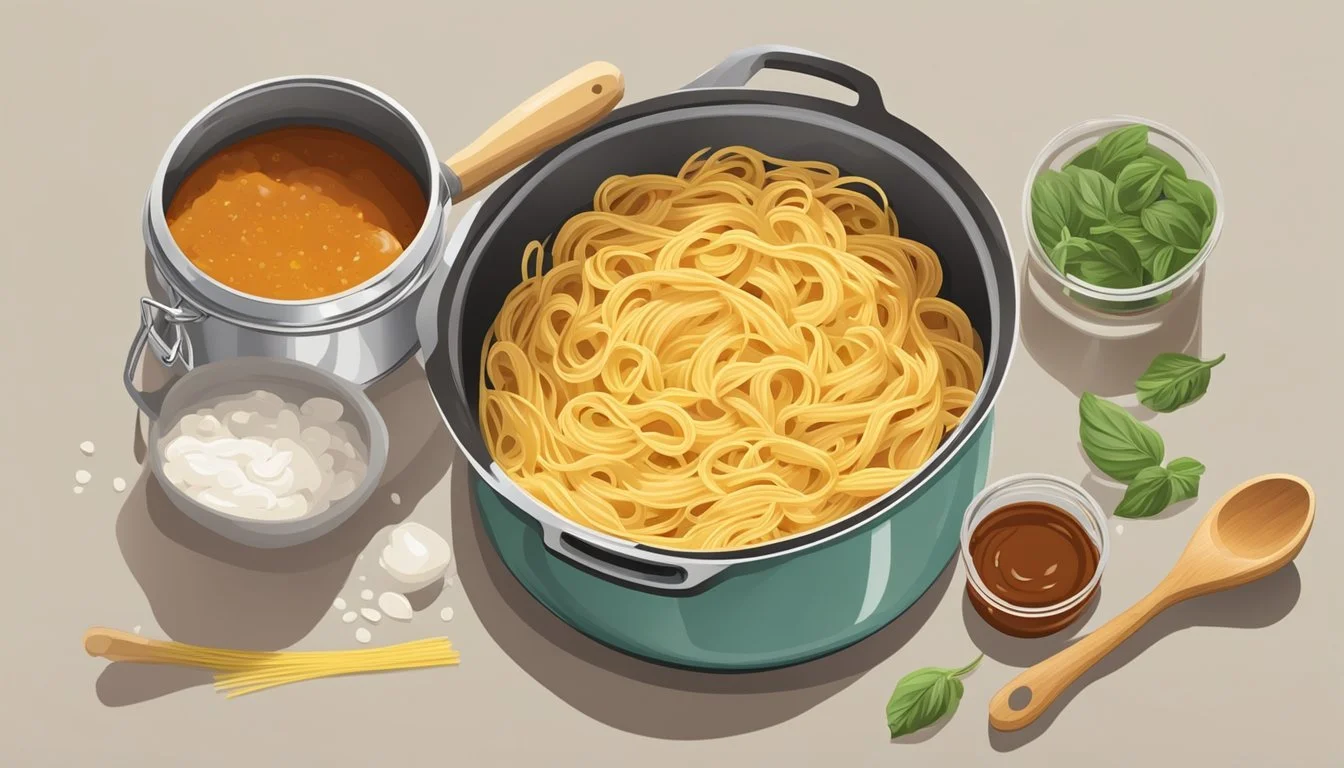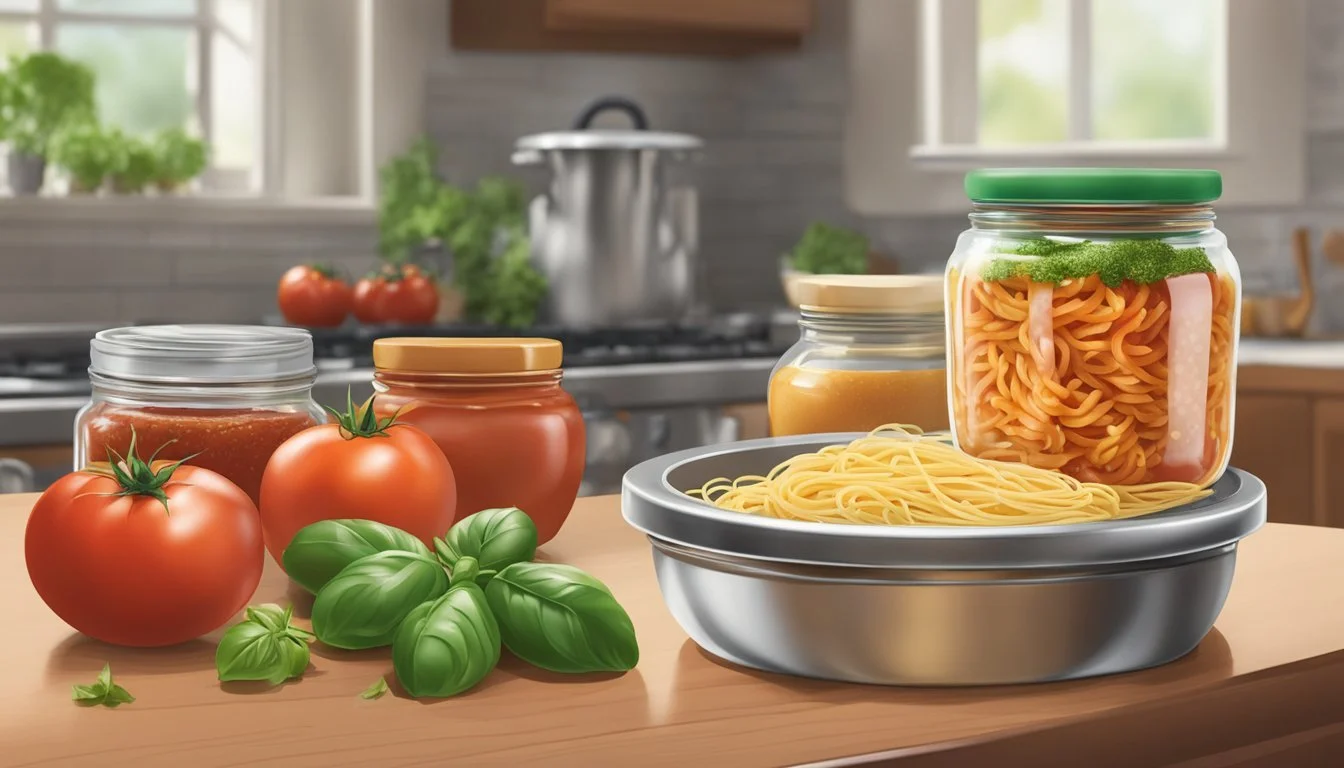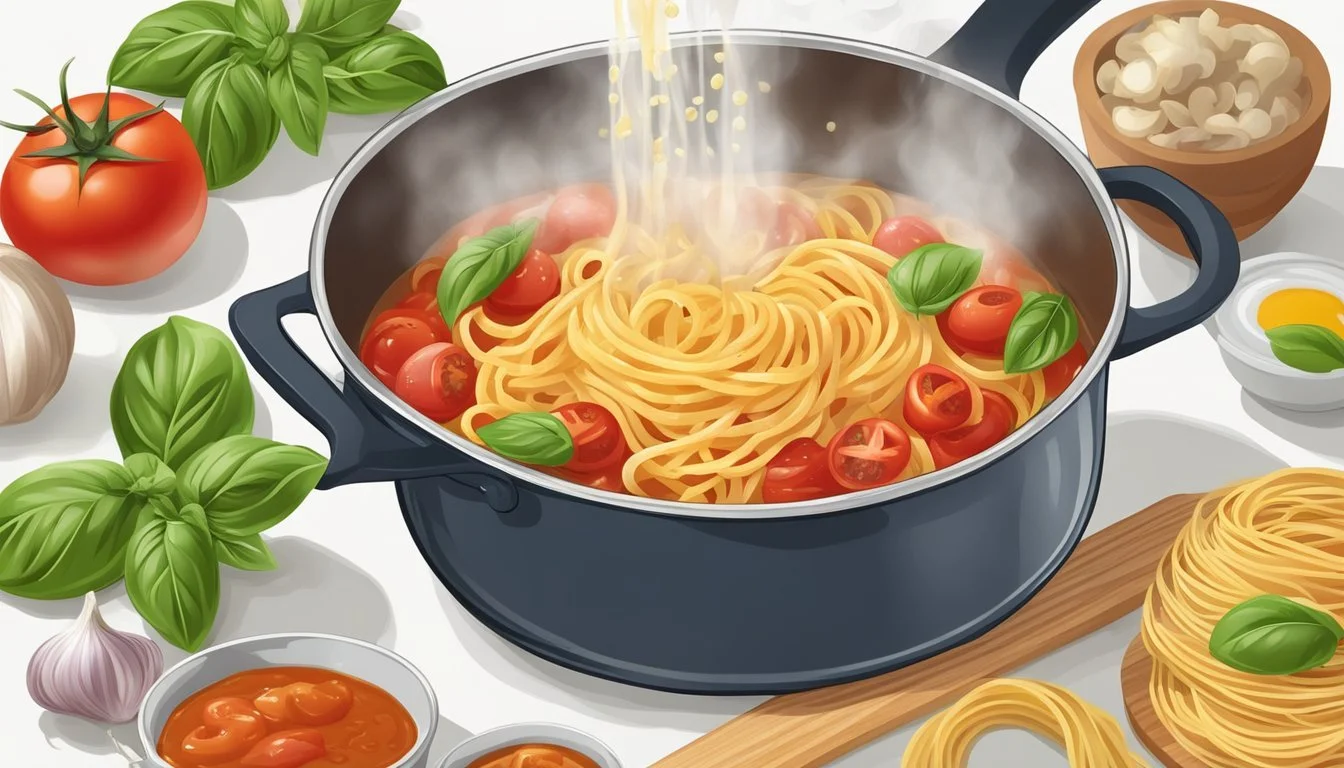How to Cook with Prego Pasta Sauce
Mastering Italian Night Favorites
Italian cuisine has a global reputation for its emphasis on fresh and high-quality ingredients, often leading to deceptively simple yet profoundly flavorful dishes. An Italian night at home can evoke the cozy ambiance of a trattoria tucked away in the heart of Rome or the rustic warmth of a Tuscan villa. Central to these comforting Italian meals is a versatile element: pasta (What wine goes well with pasta?) sauce. Prego pasta sauce, with its rich tomato base and perfectly blended herbs and spices, provides an ideal shortcut for home cooks looking to create an authentic Italian dining experience without spending hours preparing sauce from scratch.
Cooking with Prego pasta sauce offers both novice and experienced cooks the ability to craft a variety of dishes, from the classic spaghetti to more intricate lasagna layers or even as a base for a hearty meat sauce. Its consistency and depth of flavor make it a reliable pantry staple that can be easily customized. Chefs can infuse the sauce with their own choice of added ingredients such as sautéed garlic, onions, or a dash of wine to elevate the flavor profile, ensuring that each dish feels personalized and unique.
An Italian night centered around Prego sauce can be both an ode to traditional Italian cooking and a display of culinary creativity. With the sauce as the starting point, home chefs are free to explore a myriad of pasta possibilities, including baked ziti, stuffed shells, and even a simple yet sophisticated spaghetti aglio e olio with a Prego twist. The convenience of prepared pasta sauce allows more time for perfecting pasta doneness and garnishes, making way for a truly delightful Italian dining experience.
Selecting Quality Ingredients
When preparing an Italian meal with Prego pasta sauce, the excellence of your dish begins with the careful selection of high-quality ingredients. The right base like top-grade pasta and fresh produce, as well as prime proteins, elevate the flavors of the sauce, creating a memorable dining experience.
Choosing the Right Pasta
Type of Pasta: For a dish with Prego sauce, one should opt for traditional Italian pasta such as spaghetti or fettuccine. These should be made from either durum wheat semolina or a combination of semolina and high-quality flour to ensure they hold sauce well and maintain texture.
Cooking Pasta: Ensure the water is at a rolling boil before adding the pasta, along with a generous pinch of salt. Follow the recommended cooking time on the package for al dente pasta, which pairs perfectly with Prego sauce.
Selecting Fresh Vegetables and Herbs
Fresh ingredients can dramatically enhance the flavor profile of your Italian sauce. Here’s what to look for:
Herbs: Choose fresh basil and oregano for their aromatic qualities. Their flavors complement the robust tomato base of Prego sauce.
Vegetables: Incorporate vegetables like onions, garlic, mushrooms, and bell peppers. Select ones that are firm to the touch and full of color, indicating freshness and flavor intensity.
Picking the Perfect Proteins
For those who prefer a heartier sauce, adding protein is essential:
Meat Choices: Quality grade Italian sausage or lean ground beef are excellent for their rich flavors.
Vegetarian Options: In lieu of meat, consider high-protein alternatives like legumes, tofu, or textured vegetable protein.
Choosing the perfect cheese to finish the dish, such as freshly grated Parmesan or Pecorino Romano, adds a sharp, salty contrast to the sweetness of the tomato sauce. The cheese should be freshly grated right before serving to ensure maximum flavor.
Preparation Techniques
Proper preparation enhances the flavor and texture of the final dish. The following techniques will ensure key ingredients are cooked optimally before combining with Prego pasta sauce.
Sautéing Onions and Garlic
To begin, heat a tablespoon of olive oil over medium heat. One should add diced onions first, cooking them until they're translucent. Then, minced garlic is added to the mixture and sautéed just until fragrant, to avoid burning.
Onions: cook until soft
Garlic: sauté until fragrant
Browning the Meat
Whether one opts for ground beef or Italian sausage, browning the meat is a critical step. It should be added to the skillet after the onions and garlic have softened, and cooked until no pink remains. Season with salt and pepper during this process for enhanced taste.
Ground beef/Italian sausage: cook thoroughly
Season: with salt and pepper
Cooking Pasta to Al Dente
One should fill a large pot with water, add a generous pinch of salt, and bring it to a boil. Depending on personal preference, whether it's spaghetti noodles, fettuccine, penne, or rigatoni, cooking pasta until it is al dente provides the best texture.
Pasta types: spaghetti, fettuccine, penne, rigatoni
Texture: al dente for optimal firmness
Boil water: add salt for flavoring
Pasta: stir occasionally, follow package instructions for al dente results
Utilizing Prego Sauce
When cooking with Prego sauce, one can elevate the taste of their dishes and ensure a savory result by introducing additional ingredients and properly simmering the sauce.
Enhancing Flavor with Extra Ingredients
Ingredients play a vital role in enriching the inherent flavor of Prego sauce. To intensify the taste, one might consider adding:
Aromatics: Sautéed onions and minced garlic until they're fragrant and translucent.
Proteins: Ground beef or Italian sausage, browned until fully cooked.
Vegetables: Diced mushroom can contribute an earthy depth to the sauce.
Spices: A pinch of red pepper flakes for heat or a medley of Italian herbs like basil and oregano for a traditional flavor profile.
In addition to herbs and spices, a small amount of sugar can be added to balance the acidity of the tomatoes.
Simmering the Sauce to Perfection
To bring out the best in Prego sauce, a proper simmer is key. Follow these steps to ensure optimal simmering:
Transfer the sauce to a saucepan and heat over medium.
Stir in any additional ingredients, such as basil or oregano, to blend the flavors.
Reduce heat once the sauce reaches a simmer to avoid burning or over-reduction.
Cover the saucepan, letting the sauce simmer slowly, and stir periodically.
The length of simmering might vary, but it generally takes about 20 minutes for the flavors to meld appropriately. Adjust seasoning, such as salt and pepper, after the sauce has simmered to perfection.
Building the Perfect Pasta Dish
Creating the perfect pasta dish involves meticulous layering of flavors, attentive baking, and thoughtful presentation. The goal is to achieve a balanced, cohesive meal that is both easy and quick to prepare, yet delightfully complete in taste.
Layering Ingredients
Building a rich flavor profile starts with layering ingredients correctly. For a robust base, one may start by sautéing onions and garlic, then browning the chosen meat—be it beef, chicken, or sausage. It’s crucial to season the layers with salt and pepper and add herbs like basil or oregano to infuse the dish with aromatic depth. Incorporating Prego pasta sauce next ensures that the noodles, whether traditional spaghetti or a gluten-free alternative, are coated in a savory, herby tomato blend. One should not forget to sprinkle parmesan cheese between layers to elevate the dish's umami complexity.
Baking Time and Temperatures
When preparing baked pasta dishes like lasagna, casserole, or eggplant parmesan, the baking time and temperatures play a pivotal role. Preheat the oven to a temperature that allows the dish to cook through without drying out—usually between 350°F to 375°F (175°C to 190°C). Baking times can vary, but a good rule of thumb is approximately 25-30 minutes covered with foil, followed by an additional 5-10 minutes uncovered to achieve a golden-brown cheese topping.
Serving Suggestions
Finally, the presentation is key to serving the perfect pasta dish. One must ensure that each portion retains its integrity, whether it's a slice of lasagna or a serving of spaghetti topped with more sauce and cheese. Offering extra parmesan cheese and a selection of herbs allows diners to customize their dish to their preference, ensuring satisfaction. Serve with a side of crusty bread or a crisp salad for a complete, enjoyable Italian night experience.
Complementary Dishes and Pairings
When planning an Italian dinner with Prego pasta sauce as the centerpiece, one should consider dishes and beverages that enhance the flavors of the meal and create a well-rounded experience.
Creating a Balanced Italian Feast
In addition to a main dish featuring Prego sauce, one might offer garlic bread or breadsticks as a side, providing a crunchy, savory counterpoint that guests can use to savor every last bit of sauce. A crisp, fresh salad dressed lightly with olive oil and vinegar complements the richness of pasta and sauce, adding a refreshing element to the meal. For those looking to expand the menu, pizza (What wine goes well with pizza?) can be a welcome addition with Prego serving as both a pizza sauce base or a dipping sauce for crusts.
Side Dishes Role in the Meal Garlic bread / Breadsticks For sopping up sauce and adding texture Salad To introduce a crisp, fresh contrast Pizza As an alternative or addition, with sauce versatility
Wine and Beverage Choices
The selection of wine is crucial to any Italian feast. A robust red like Chianti or Merlot pairs well with tomato-based pasta dishes (What wine goes well with pasta dishes?) that include Prego sauce, balancing the acidity and complementing the flavors. For lighter pasta dishes or for guests preferring white wine, a Pinot Grigio or Sauvignon Blanc provides a crisp, refreshing complement. Non-alcoholic options might include sparkling water garnished with a twist of lemon or a rich, tangy Italian lemonade, keeping the palate cleansed between bites.
Beverage Type Recommended Pairings Red Wine Chianti, Merlot White Wine Pinot Grigio, Sauvignon Blanc Non-Alcoholic Sparkling water, Italian lemonade
Storage and Leftovers
To ensure the quality and safety of leftover pasta and Prego pasta sauce, proper storage methods are key. One's ability to enjoy Italian delights can be greatly extended with the right cooling and reheating techniques.
Proper Cooling and Storing Methods
After enjoying a meal, promptly placing leftovers in an airtight container is crucial for maintaining freshness. For the Prego pasta sauce specifically, any remaining sauce should be transferred to a container and sealed tightly to prevent contamination and preserve flavor. These leftovers can be stored in the fridge for 5-10 days. If one does not plan to consume the sauce within this timeframe, storing it in the freezer is an effective alternative.
Fridge: Place in an airtight container and use within 5-10 days.
Freezer: Ensure the sauce cools down before sealing and placing into the freezer to prevent ice crystal formation.
Reheating for Best Quality
When reheating spaghetti with Prego sauce or the sauce by itself, evenly spreading heat throughout the dish is vital for best taste and texture.
Stovetop: Pour the sauce into a pan and reheat it over medium heat until it is thoroughly warmed.
Microwave: Use a microwave-safe dish, cover with a lid or microwave-safe plastic wrap, and reheat in increments of 30 seconds, stirring in between to ensure even heating.
One should avoid repeatedly reheating leftovers, as this can compromise both quality and safety. It is always best to only reheat the portion that will be consumed immediately.
Dietary Adjustments and Alternatives
When hosting an Italian night, it's important to consider the diverse dietary needs of your guests. By offering gluten-free options and vegetarian or vegan variations, everyone can enjoy the rich flavors of Italian cuisine with Prego pasta sauce.
Offering Gluten-Free Options
For guests with gluten sensitivities, replace traditional pasta with gluten-free alternatives made from rice, corn, or quinoa. Prego sauce itself is naturally gluten-free, making it a suitable choice for gluten-free dishes. When preparing gluten-free pasta, it's crucial to ensure that the water doesn't cross-contaminate with gluten-containing products.
Gluten-Free Pasta: Look for brands that certify their pasta is gluten-free.
Cross-Contamination: Use separate utensils and pots to prevent any gluten exposure.
Vegetarian and Vegan Variations
To cater to vegetarian and vegan diets, omit any meat products and introduce plant-based substitutes. Since cheese is a common ingredient in Italian dishes, source vegan cheese options to maintain the creamy texture loved by many.
Vegetarian Adjustments:
Cheese: Use vegetarian parmesan that doesn't contain animal rennet.
Herbs: Incorporate aromatic herbs like dried basil and dried oregano to enhance flavor.
Mushrooms: Add sautéed mushrooms for a meaty texture without the meat.
Vegan Variations:
Crushed Tomatoes: Ensure the tomato base of Prego sauce suits vegans.
Vegan Cheese: Utilize vegan cheese to replicate the melted, gooey element.
Protein: Add legumes such as lentils or chickpeas for a hearty protein boost.
Quick Tips and Tricks
In this section, readers will discover how to enhance the flavor and consistency of Prego pasta sauce and how to streamline their cooking process for a delightful Italian night.
Boosting Taste and Thickness
To elevate the flavor of Prego sauce, they can consider simmering it on a low heat to allow the spices and seasonings to meld together. This can result in a richer taste. Here are specific tips for enhancing flavor:
Seasonings: Incorporate a pinch of salt and pepper to taste. Adding a mix of Italian spices like oregano, basil, and thyme can also dramatically improve flavor.
Saute Onions and Garlic: Before adding the sauce to the pan, sauté onions and garlic until they're translucent and fragrant.
Sugar: A teaspoon of brown sugar may be stirred in to balance acidity.
Simmering Sauce: Allow the sauce to simmer for several minutes to help flavors combine and the sauce to thicken slightly.
To make the Prego sauce thicker, they can use starch. Tossing the pasta in the sauce can also help, as the starch from the pasta naturally thickens the sauce.
Maximizing Kitchen Efficiency
For a quick and easy preparation, they can follow these steps:
Cook Pasta Concurrently: Begin boiling water for the pasta so it cooks while they prepare the sauce.
Ready Ingredients: Prepping all ingredients before cooking—chopping onions, measuring spices, and mincing garlic—can save time.
Batch Cooking: If they're entertaining, making a larger quantity of sauce can be efficient. Leftovers can be stored for future meals.
Use Leftover Pasta Water: The starchy pasta water can be added to the sauce to adjust consistency and add flavor.
Enhancements and Customizations
Before diving into the unique ways to customize Prego pasta sauce, it's essential to consider how one can enrich the sauce to better suit individual palates and broaden its use beyond traditional pasta dishes.
Incorporating Personal Touches
To turn a canned Prego sauce into a more personalized version, consider adding Italian sausage for a hearty flavor. Brown the sausage in a pan, breaking it into small pieces as it cooks, then stir it into the sauce to complete the base of your dish. Additionally, infusing the sauce with herbs such as basil, oregano, or thyme can elevate the flavors. A simple yet effective tip is to simmer the sauce with these herbs, allowing their flavors to meld with the tomato puree base of the Prego sauce.
Creative Uses for Prego Sauce
Beyond spaghetti sauce, Prego can serve as a versatile ingredient. In the realm of the kitchen, it can act as a pizza sauce to quickly craft a homemade pizza. Spread Prego sauce over the dough, add desired toppings, and bake until crisp. Prego can also transform into a tomato soup base with the addition of stock and cream, simmered until rich and creamy.
This approach not only expands the sauce's versatility but also showcases its potential as a foundational element for various Italian-inspired dishes.
Health and Nutritional Information
When preparing a meal with Prego pasta sauce, it's important to consider the health and nutritional information. This includes understanding the caloric and macronutrient content, as well as how to balance the meal to meet various dietary goals.
Caloric and Macronutrient Breakdown
Prego pasta sauce typically contains calories that primarily come from carbohydrates and to a lesser extent from fats and proteins. Here is a general nutritional breakdown for a serving of Prego sauce:
Calories: Approximately 70-100 per 1/2 cup serving
Protein: Generally around 2 grams per serving
Carbohydrates: About 12-18 grams per serving
Fats: 2-4 grams per serving
Fiber: 2-4 grams per serving
Adding vegetables like spinach, bell peppers, or zucchini to the sauce can increase its fiber content and nutritional value.
Balancing the Meal for Dietary Goals
To create a balanced meal, one should combine Prego pasta sauce with a source of protein and a variety of vegetables. This not only enhances the taste but also ensures a well-rounded nutritional profile. For example, adding lean ground turkey or chicken to the sauce can boost protein intake, which is essential for muscle repair and satiety. Integrating whole-grain pasta can further increase the meal's fiber content, supporting digestive health.
For individuals following specific diets, the choice of pasta, as well as additional ingredients mixed into the sauce, can be adjusted. Opting for gluten-free pasta or vegetable noodles can cater to those on gluten-free or low-carbohydrate diets. Assessing the sugar and sodium levels in the sauce is also crucial for those monitoring their intake for health reasons.
Conclusion
Cooking with Prego pasta sauce can elevate a simple Italian night at home to a delightful culinary experience. The ease of using this pre-made sauce allows both novices and seasoned cooks to infuse rich flavors into their dishes. Incorporating the sauce into classic spaghetti or experimenting with unique pasta varieties can impress any palate.
A few tips can enhance the taste and quality of a Prego sauce-based meal:
Simmering: Allowing the sauce to simmer can deepen its flavor profile.
Sautéing: Sauté onions and garlic before adding the sauce to introduce a savory dimension.
Meat Options: For a heartier dish, integrating browned ground beef or crumbled Italian sausage can add both texture and substance.
Customization: Personalizing dishes with vegetables, herbs, or cheese can cater to individual preferences.
Remember, the pasta should be cooked al dente and the sauce should be heated through, ensuring that every bite is as enjoyable as it is memorable. When all components combine harmoniously on the plate, they create a comforting and satisfying Italian meal. Whether it's a weeknight dinner or a special occasion, these simple techniques with Prego pasta sauce promise to deliver authentic flavor with minimal effort.

